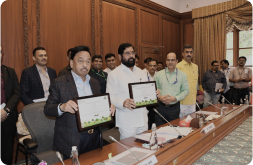










Project Target
99% Remaining
4,237
Trees Planted out of 300,000 Trees

Project Location:
In FY 2025-26, we will be planting 150,000 trees in Burshi village in Naugaon Block, Uttarkashi district, Uttarakhand. This will be in addition to the 150,000 trees we planted in FY 2024-25 across various villages in the Uttarkashi district, Uttarakhand.
Project Aim
SDG
Why Trees?
Barkot, once a hidden gem of Uttarkashi, is now facing the harsh consequences of climate change. The area is facing multiple challenges - water scarcity, a loss of green cover and despite its high altitude of ~1220m, it is experiencing unusually warm temperatures.
Global Forest Watch suggests that over the past two decades, Uttarkashi has experienced significant loss of its green cover, with 218 hectares attributed to forest fires and 725 hectares lost to various other factors.[1] The combination of heavy rainfall and debilitating tree cover poses a heightened risk of landslides in the region. To mitigate these risks, tree plantation emerges as a viable solution. Trees play a crucial role in stabilising soil, decreasing water runoff, and acting as natural barriers against extreme weather events such as floods, landslides, and droughts. Therefore, implementing tree plantation initiatives is essential to safeguarding Uttarkashi against the adverse impacts of natural disasters.
Due to its remote location and sparse human habitation, Uttarkashi district boasts abundant flora and fauna, with forest cover estimated to range from 60% to 80%.[2] This region is a haven for a diverse array of wildlife, including various feline species like leopards, tigers, and wild cats. Additionally, both black and brown bears are frequently sighted here. Among the antelope species, Bharal and Himalayan Serows are unique to the high-altitude forests of the Himalayas and can be found in this district.
The region also hosts a rich diversity of reptiles and birds. Approximately 30 species of snakes inhabit this area, predominantly non-venomous, although the infamous "big four" venomous snakes—common krait, Russell's viper, cobra, and saw-scaled viper—are also present. Monitor lizards are abundant in this region as well.
Moreover, Uttarkashi district is renowned for its wide variety of bird species. Notable avian inhabitants include the Himalayan snow cock, Monal, magpies, thrushes, orioles, paradise flycatchers, and sunbirds, among others. This rich biodiversity underscores the ecological significance of preserving and protecting the natural habitats within Uttarkashi.[3]
Tree Species
Local tree species were the primary focus of the tree plantation drive in the area. The trees in this project include Molu oak (Quercus floribunda), Banj (Quercus leucotrichophora), Silver oak (Grevillea robusta), Himalayan cedar (Cedrus deodara), Apple (Malus domestica), Lemon (Citrus limon) and Apricot (Prunus armeniaca).
Each tree serves a purpose - from providing shade to absorbing carbon dioxide and cleaning the air to providing forest produce. Banj trees provide excellent shade and help clean the air. In India, Silver Oak trees are essentially honey trees because their nectar is processed and sold as honey. Deodar Cedar is renowned for its value and has been used for this purpose for a long time.
Preserving and cultivating local species and carefully selecting the right trees is crucial in safeguarding the integrity of an exquisite ecosystem.
Social Impact
Planting trees offers numerous benefits that span across multiple aspects.*
Plantation here will contribute in enhancing air quality, mitigating the impact of landslides and cloud bursts which are common in this area.
Supporting local communities is at the heart of this project. We involve them in our plantation activities, allowing them to generate supplementary income as well. Our tree plantation activities provide employment for women too.
Groundwater recharge is a vital process wherein water, primarily from rainfall and other sources, permeates into the ground, replenishing underground water sources. This is crucial for ensuring an adequate supply of water for various essential purposes such as drinking, agriculture, and other human needs. Trees play a pivotal role in mitigating water runoff, offering significant benefits to the community in Barkot. Not only do trees help prevent soil erosion, but they also address the pressing issue of water scarcity in the region.
To ensure that our efforts have a positive impact on the environment, we conduct a rigorous assessment of the site and carefully select the trees that align with the location and the community. Trees do an excellent job absorbing carbon dioxide from the atmosphere and cooling the air. This will contribute significantly to boosting the local tourism industry.
Livestock is a major source of sustenance for the residents of Barkot. Planting trees will provide ample fodder to meet the needs of their livestock.
*The environmental benefits of the trees reach their full potential as they mature.
[1] Uttarkashi, Uttarakhand, India Deforestation Rates & Statistics | Global Forest Watch
[3] Shivani Pathak (2020). Mapping snakes in Uttarakhand for safer coexistence with humans | Mongabay
Social Impact of Growing Trees
Community Engagement
Tree planting initiatives often involve local communities, which can lead to greater community cohesion.
Ecological Education
Provides opportunities for community members, especially children, about the importance of environmental sustainability.
Urban Beautification
Trees contribute to the aesthetic enhancement of urban areas, making cities more pleasant and liveable.
Climate Resilience
By improving green cover, tree planting helps make communities more resilient against climate impacts like heatwaves.
Employment Creation
Planting trees creates employment for local community members like planting and maintenance, administrative roles, and more long-term jobs in management.
Wildlife Habitat
Trees provide critical habitats for various species of wildlife. Enhancing tree cover helps preserve biodiversity, which can be an ecological boon for local communities
Copyrights @ 2025 All rights reserved by Pangea EcoNetAssets Pvt Ltd.